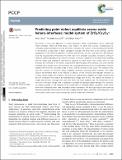| dc.contributor.author | Yang, Jing | |
| dc.contributor.author | Youssef, Mostafa Youssef Mahmoud | |
| dc.contributor.author | Yildiz, Bilge | |
| dc.date.accessioned | 2017-04-05T20:40:12Z | |
| dc.date.available | 2017-04-05T20:40:12Z | |
| dc.date.issued | 2016-12 | |
| dc.date.submitted | 2016-07 | |
| dc.identifier.issn | 1463-9076 | |
| dc.identifier.issn | 1463-9084 | |
| dc.identifier.uri | http://hdl.handle.net/1721.1/107888 | |
| dc.description.abstract | We present a multi-scale approach to predict equilibrium defect concentrations across oxide/oxide hetero-interfaces. There are three factors that need to be taken into account simultaneously for computing defect redistribution around the hetero-interfaces: the variation of local bonding environment at the interface as epitomized in defect segregation energies, the band offset at the interface, and the equilibration of the chemical potentials of species and electrons via ionic and electronic drift-diffusion fluxes. By including these three factors from the level of first principles calculation, we build a continuum model for defect redistribution by concurrent solution of Poisson's equation for the electrostatic potential and the steady-state equilibrium drift-diffusion equation for each defect. This model solves for and preserves the continuity of the electric displacement field throughout the interfacial core zone and the extended space charge zones. We implement this computational framework to a model hetero-interface between the monoclinic zirconium oxide, m-ZrO[subscript 2], and the chromium oxide Cr[subscript 2]O[subscript 3]. This interface forms upon the oxidation of zirconium alloys containing chromium secondary phase particles. The model explains the beneficial effect of the oxidized Cr particles on the corrosion and hydrogen resistance of Zr alloys. Under oxygen rich conditions, the ZrO[subscript 2]/Cr[subscript 2]O[subscript 3] heterojunction depletes the oxygen vacancies and the sum of electrons and holes in the extended space charge zone in ZrO[subscript 2]. This reduces the transport of oxygen and electrons thorough ZrO[subscript 2] and slows down the metal oxidation rate. The enrichment of free electrons in the space charge zone is expected to decrease the hydrogen uptake through ZrO[subscript 2]. Moreover, our analysis provides a clear anatomy of the components of interfacial electric properties; a zero-Kelvin defect-free contribution and a finite temperature defect contribution. The thorough analytical and numerical treatment presented here quantifies the rich coupling between defect chemistry, thermodynamics and electrostatics which can be used to design and control oxide hetero-interfaces. | en_US |
| dc.language.iso | en_US | |
| dc.publisher | Royal Society of Chemistry | en_US |
| dc.relation.isversionof | http://dx.doi.org/10.1039/C6CP04997D | en_US |
| dc.rights | Creative Commons Attribution 3.0 Unported license | en_US |
| dc.rights.uri | http://creativecommons.org/licenses/by/3.0/ | en_US |
| dc.source | Royal Society of Chemistry | en_US |
| dc.title | Predicting point defect equilibria across oxide hetero-interfaces: model system of ZrO[subscript 2]/Cr[subscript 2]O[subscript 3] | en_US |
| dc.title.alternative | Predicting point defect equilibria across oxide hetero-interfaces: model system of ZrO2/Cr2O3 | en_US |
| dc.type | Article | en_US |
| dc.identifier.citation | Yang, Jing, Mostafa Youssef, and Bilge Yildiz. “Predicting Point Defect Equilibria across Oxide Hetero-Interfaces: Model System of ZrO[subscript 2]/Cr[subscript 2]O[subscript 3].” Phys. Chem. Chem. Phys. 19.5 (2017): 3869–3883. © Royal Society of Chemistry 2017 | en_US |
| dc.contributor.department | Massachusetts Institute of Technology. Department of Materials Science and Engineering | en_US |
| dc.contributor.department | Massachusetts Institute of Technology. Department of Nuclear Science and Engineering | en_US |
| dc.contributor.mitauthor | Yang, Jing | |
| dc.contributor.mitauthor | Youssef, Mostafa Youssef Mahmoud | |
| dc.contributor.mitauthor | Yildiz, Bilge | |
| dc.relation.journal | Physical Chemistry Chemical Physics | en_US |
| dc.eprint.version | Final published version | en_US |
| dc.type.uri | http://purl.org/eprint/type/JournalArticle | en_US |
| eprint.status | http://purl.org/eprint/status/PeerReviewed | en_US |
| dspace.orderedauthors | Yang, Jing; Youssef, Mostafa; Yildiz, Bilge | en_US |
| dspace.embargo.terms | N | en_US |
| dc.identifier.orcid | https://orcid.org/0000-0003-1855-0708 | |
| dc.identifier.orcid | https://orcid.org/0000-0001-8966-4169 | |
| dc.identifier.orcid | https://orcid.org/0000-0002-2688-5666 | |
| mit.license | PUBLISHER_CC | en_US |
| mit.metadata.status | Complete | |
